Intro to stats Study guides, Class notes & Summaries
Looking for the best study guides, study notes and summaries about Intro to stats? On this page you'll find 224 study documents about Intro to stats.
Page 3 out of 224 results
Sort by
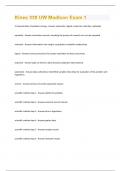
-
Kines 330 UW Madison Exam 1 Questions & Answers Already Graded A+
- Exam (elaborations) • 11 pages • 2024
- Available in package deal
-
- $9.99
- + learn more
5 characteristics of problem solving - Answer-systematic, logical, empirical, reductive, replicable repicable - Answer-instruction manual, recording the process of research so it can be repeated reductive - Answer-information into insight; using data to establish relationships logical - Answer-correct procedures for proper evaluation to draw conclusions empirical - Answer-data on which to base decisions (objective observations) systematic - Answer-data collected on identified variables that...
University of Maryland University College Sophia __ Intro to Stats Unit 2 Milestone 2 STAT200 7979

-
Test Bank for Intro to Python for Computer Science and Data Science-Learning to Program with AI, Big Data and The Cloud 1Ed. by Paul Deitel, Harvey Deitel- Elaborated and Complete
- Exam (elaborations) • 340 pages • 2023
-
- $37.59
- + learn more
Test Bank for Intro to Python for Computer Science and Data Science-Learning to Program with AI, Big Data and The Cloud 1Ed. by Paul Deitel, Harvey Deitel- Elaborated and Complete ISBN-10 3 ISBN-13 978-6 PART 1 CS: Python Fundamentals Quickstart CS 1. Introduction to Computers and Python DS Intro: AI–at the Intersection of CS and DS CS 2. Introduction to Python Programming DS Intro: Basic Descriptive Stats CS 3. Control Statements and Program Developm...
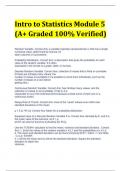
-
Intro to Statistics Module 5 (A+ Graded 100% Verified)
- Exam (elaborations) • 2 pages • 2023
-
Available in package deal
-
- $6.79
- 1x sold
- + learn more
Intro to Statistics Module 5 (A+ Graded 100% Verified) Random Variable Correct Ans: a variable (typically represented by x) that has a single numerical value, determined by chance, for each outcome of a procedure. Probability Distribution Correct Ans: a description that gives the probability for each value of the random variable. It is often expressed in the format of a graph, table, or formula. Discrete Random Variable Correct Ans: collection of values that is finite or counta...
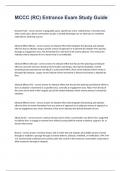
-
PACKAGE DEAL OF MCCC QUESTIONS WITH COMPLETE SOLUTION 2023/2024
- Package deal • 19 items • 2024
-
- $40.49
- + learn more
Intro to Statistics MCCC Ch Question and answers rated A+ 2023/2024 Exam (elaborations) Intro to Stats MCCC Ch. 5 Questions with complete solution 2023/2024 Exam (elaborations) MCCC (RC) Entrance Exam Study Guide Question and answers correctly solved 2023/2024 Exam (elaborations) MCCC A1 quiz Question and answers 2023/2024 verified to pass
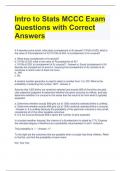
-
Intro to Stats MCCC Exam Questions with Correct Answers
- Exam (elaborations) • 7 pages • 2024
-
- $7.69
- + learn more
Intro to Stats MCCC Exam Questions with Correct Answers If A denotes some event, what does (complement of A) denote? If P(A)=0.003, what is the value of P(complement of A)? If P(A)=0.003, is (complement of A) unusual? a. What does (complement of A) denote? b. If P(A)=0.003, what is the value of P(complement of A)? c. If P(A)=0.003, is (complement of A) unusual? - Answer-a. Event (complement of A) denotes the complement of event A, meaning that (complement of A) consists of all outcome...

-
Sophia Intro to Stats Unit 5 Milestone 5,
- Exam (elaborations) • 23 pages • 2023
-
- $19.49
- + learn more
RATIONALE Using the z-chart to construct a 97% CI, this means that there is 1.5% for each tail. The lower tail would be at 0.015 and the upper tail would be at (1 - 0.015) or 0.985. The value of 0.9850 is actually on the z-table exactly. 0.9850 corresponds with a z-score of 2.17. CONCEPT Confidence Intervals 2 George measured the weight of a random sample of 49 cartons of apples. The mean weight was 45.5 pounds, with a standard deviation of 3. To see if the cartons have a significant...
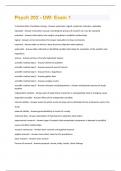
-
Psych 202 - UW: Exam 1 Questions and Answers with complete
- Exam (elaborations) • 2 pages • 2024
- Available in package deal
-
- $10.49
- + learn more
5 characteristics of problem solving - Answer-systematic, logical, empirical, reductive, replicable repicable - Answer-instruction manual, recording the process of research so it can be repeated reductive - Answer-information into insight; using data to establish relationships logical - Answer-correct procedures for proper evaluation to draw conclusions empirical - Answer-data on which to base decisions (objective observations) systematic - Answer-data collected on identified variables that...

-
Sophia Intro to Stats Unit 2 Milestone 2.
- Exam (elaborations) • 20 pages • 2023
-
- $18.99
- + learn more
In which of these cases should the median be used? When the data has small variance When data has no outliers When the data has extreme values When the data has nominal values RATIONALE Since the mean uses the actual values in the data, it is most affected by outliers and skewness. So, we only want to use the mean when the data is symmetric as a measure of centrality. When the data is skewed or has extreme values, the median is a better measure since it is not as sensitive to the...

-
Sophia Intro to Stats Unit 3 Milestone 3
- Exam (elaborations) • 16 pages • 2023
-
- $19.49
- + learn more
Which of the following is a property of binomial distributions? All of the observations made are dependent of each other. There are exactly four possible outcomes for each trial. The expected value is equal to the number of successes in the experiment. The variable of interest is the total number of successes or failures for a given number of observations. RATIONALE Recall that for the binomial distribution we are concerned with an event occurring (successes) or not occurring (fail...

Did you know that on average a seller on Stuvia earns $82 per month selling study resources? Hmm, hint, hint. Discover all about earning on Stuvia



